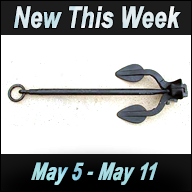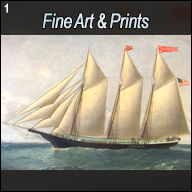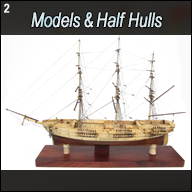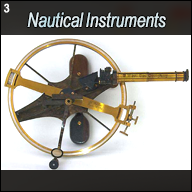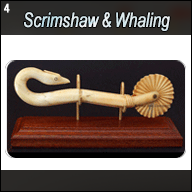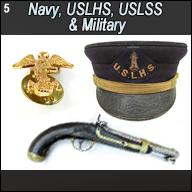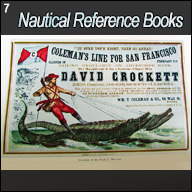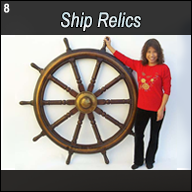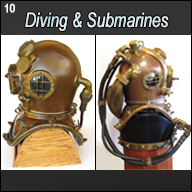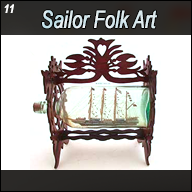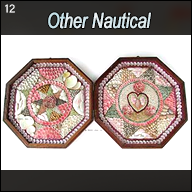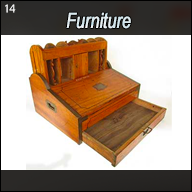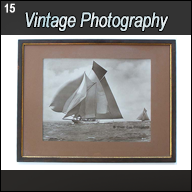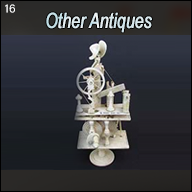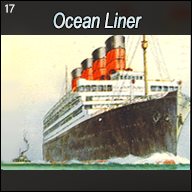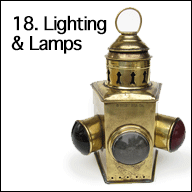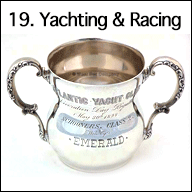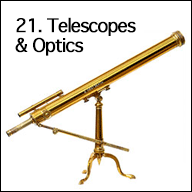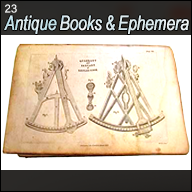Hall of Fame
OUTSTANDING NAUTICAL ANTIQUES AND ART SOLD FROM THIS WEBSITE
Page 2 of 7
Pages « 1 2 3 4 5 6 7 »
SHIP PORTRAIT. Thomas Willis, American 19th C., oil on canvas with silk embroidery of the graceful 19th C. American steam/sail yacht DAGMAR underway at sea. Several crewmen are depicted on deck, with headlands and a lighthouse on a point visible in the distance. Here is an example of Willis' artistry clearly typifying his mastery of this medium -- of which he is the self-described "inventor." The stitchery is remarkable in its precision, down to details such as stars on the flag and faces of the crewmen! This painting is in excellent, crisp, original condition, evidencing only minor repair to the original canvas which is on the original stretcher and NOT re-lined. Signed LR "T. Willis." 17 1/2 by 23 1/2 inches sight, and housed in the original ornate Victorian gesso on wood frame with gold liner and original glass. The frame measures 22 by 28 inches. Circa 1900. A brighter "Willis" is not to be found!
The steam/sail yacht DAGMAR is depicted flying the burgee of the American Yacht Club, New York City from the foremast and the the owner's flag from the mainmast. Willis himself was a New Yorker.
MODEL. Exceptional early 20th C. hand-crafted model of the famous American whaleship Wanderer of New Bedford, Massachusetts. This realistic model includes many details frequently omitted in lesser models: carved wooden figurehead, hand-painted sternboard and nameboards, tryworks, windlass, deck grindstone and forge, fife rail, post and pintle rudder, hand-tied rat lines, rolling block ship's wheel, authentically-detailed skylight, cutting stage, authentic standing and running rigging, fully fitted-out whaleboats, and numerous other subtle earmarks of quality. This solid hull model measures 27 inches long x 20 1/2 inches tall x 9 1/2 inches wide. The original wooden case with old glass measures 31 1/2 inches long x 24 inches high x 13 inches deep. Included is an ACTUAL RELIC from the Wanderer, a section of her oak hull containing the brass nails used to attach copper hull sheathing. It is identified with an applied engraved brass plaque which is set within the case, serving as a very valuable, unique model presentation! A very rare, historically significant, and handsome presentation.
18th CENTURY DOUBLE FRAME SEXTANT BY THE INVENTOR. Magnificent, very early English navigational sextant of the finest quality made by “Troughton, London” as engraved on the large arc. This classic “double frame” sextant, was also known as the “pillar frame” sextant, so named because it consisted of 2 frames of sheet brass braced together with brass pillars. The scale is divided on silver from -5 degrees to 145 degrees subdivided to 10 arc minutes. The braced index arm has a silver vernier calibrated from 0 to10 minutes, subdivided for a reading down to 10 arc seconds. A pivoting magnifier is mounted on the arm to take the fine reading. The arm is equipped with positive stop and tangential fine adjust knobs. This large, all brass sextant has both index and horizon mirrors plus full sets of index and horizon filters. The height-adjustable telescope holder is controlled by a knurled knob on the reverse. The sculpted rosewood handle and three “feet” complete the back side. It measures 12 inches long on the index arm and just over 13 inches wide on the large arc. Condition is nothing short of extraordinary with clean, sharp, crisp surfaces in its original bright finish throughout. The scale is perfect. This instrument measures 12 ¾ high by 15 ¼ inches wide. The hand-dovetailed, shaped “keystone” mahogany box is of early form with all 4 sighting tubes. It has a hook and eye closure and the original box lock with skeleton key. The lid bears the distinctive early label of Samuel Thaxter & Son, Boston, which attests to the fact that this sextant was used in America in the early days of sail. It measures 12 ¾ high by 15 ¼ inches wide. This sextant is truly remarkable. Its construction speaks of untold man hours spent in careful fabrication with the tiniest of components melded together to form a functional mechanical work of art. It is an absolutely flawless museum piece!
Edward Troughton invented the double or "pillar frame" sextant in 1788, constructing it with two thin brass sheets held together with turned support pillars. This innovative lightweight design provided a rigid platform necessary for a hand-held instrument to take accurate celestial observations. While the double frame proved to be an effective 18th C. concept -- one which gave Troughton great notoriety as a respected instrument maker -- the complexity and cost of producing such sextants gave way to more simplified designs by the early 1800's. The low 3 digit serial number engraved on the vertical strut, indicates this superb example dates 1798.
IDENTIFIED SHIP'S FIGUREHEAD. Spectacular 19th Century carved and painted wooden ship's figurehead from the North American bark EDINBURGH. This stunning example of the ship carver's art is dressed in classical attire, adornmed with a ribbon-carved gilt necklace and tiara, central oval brooch and bracelets on each wrist. She poses a striking stance, forward leaning with her right arm across her bosom as she stands on the original base, flanked by Acanthus scrolls. This important artifact was sculpted by the well known Canadian wood carver John Rogerson (1837-1925) who worked in St. John, New Brunswick in the second half of the 19th century. The figurehead stands 73 inches tall inclusive of its small wooden display pedestal and weighs approximately 400 pounds. It is in an outstanding state of preservation with approximately 90% original surfaces and paint.
The EDINBURGH was a Canadian-built and registered 3-masted barque of 203 1/2 feet launched by William Charland, Jr. of St. Joseph de Levis Quebec, Canada in 1883. After 26 years of service, she met her demise in the port of Bermuda where she foundered in 1909. This figurehead was first owned by the American Consul to Bermuda, William H. Allen and was proudly displayed in his garden for several years. In the 1920's she became the property of Francis Turnbull Meyer, a successful businessman from New York. Mr. Meyer, long a patron of the arts, donated the figurehead to the Addison Gallery of American Art at the Phillips Academy, Andover, Massachusetts in 1933 where it was on public exhibit in the Maritime Wing until 2002.
This famous figurehead is well documented in associated literature. In the book "Shipcarvers of North America," M.V. Brewington, 1962, Barre publishing Co., Barre, Massachusetts, the entire page 94 is devoted to a full length photograph of the figurehead with accompanying text. In the landmark work "Treasury of American Design" by Clarence Hornung, published by Abrams, Inc., New York, 1976, the first chapter is entitled "Forgotten Figures Fore and Aft." The frontispiece of chapter I, page 6, is the full page image of this beautiful figurehead.
EARLY HARPOON. Very rare and especially desirable early 19th century American "double flue" whaling harpoon. This hand forged example of the blacksmith's art features a graceful "arrowhead" tip atop a square shank which tapers to a narrow round shaft then gradually expands at the base, terminating in a split cone which accommodated the wooden harpoon pole. In use, this harpoon would have been whipped to a line and loosely affixed on the end of a cut sapling pole. Once darted into the whale the pole fell away and the line, made fast to the boat, often towed its occupants on a famous "Nantucket Sleigh Ride." This is a genuine whaling harpoon, over 150 years old, and is the type of harpoon used when Nantucket was in its heyday as the whaling capital of the world in the 1830's and 40's. It is in an excellent original state of preservation with a lovely weathered surface, rich in color and texture. This is an unusually long example of whalecraft measuring 39 1/2 inches in length and 4 1/2 inches broad at the tip. A museum piece.
In his reference work "Harpoons and Other Whalecraft," 1984 Old Dartmouth Historical Society, New Bedford, Massachusetts, author Thomas Lytle states "By the mid-eighteenth century the use of drugs (as in "drogue") was largely abandoned in favor of fastening the whaleboat itself to the whale by means of a "tow iron." Clifford Ashley, in his book "The Yankee Whaler," states that this change took place between 1761 and 1782." The type of harpoon used is described as a "two-flued iron." "The earliest Untied States patent for an improved harpoon was granted to William Carsley of New Bedford in 1841. Carsely's invention was simple -- it merely called for twisting the two flues of an iron in opposite directions." However, credit for the greatest innovation in whaling fell to the African American blacksmith Lewis Temple, who first produced a toggle iron in 1848. "It has since been known as "Temple's gig," or the "Temple Iron." It was quickly proven, widely accepted, and became standard in the industry." Therefore we can state with reasonable certainty that the two flued iron offered here dates prior to 1850.
LIGHTHOUSE LAMP. Exceptionally rare and important primary light source for a U.S. Lighthouse Service 4th Order lighthouse. This heavy solid brass lamp with riveted handle measures 9 inches across and stands 10 inches tall to the top of the burner. It contains a complex aspiration system with round wick which was designed to produce maximum light within the constraints of an oil burning light source. Affixed to the side is the brass label reading "4th ORDER." Condition is sound, noting a dent on the back side. A wonderful lighthouse relic.
EARLY E.O.T. Very nice late 19th century, probably American, ship's pilot house engine order telegraph from a single screw steam vessel. This unusual ship's relic has a 10 3/4 inch solid brass dial inset with milkglass "windows." Each window is hand painted with the standard engine indications "SLOW, HALF, FULL," etc. and the additional colored markings for "AHEAD" and "ASTERN." The indicator is operated by a turned wooden handle which is affixed to a graceful swan neck pointer. In practice the pilot house would indicate the desired engine setting and the engineroom would acknowledge the signal with a ring of the bell accompanied by movement of the center arrow. This means of "telegraphing" was instituted on early pre-electric steamships as a safe and secure way of passing signals mechanically. It was accomplished by a complex system of pulleys, chains, and cables. This telegraph has now been equipped to ring the internal bell and to operate both arrows simultaneously by moving the handle. The bell rings with a loud pleasing tone with each engine setting. What is remarkable about this telegraph is that it is still retains the original mushroom top side light for night operation! This all brass oil lamp has an internal silvered reflector on the hinged door which bears two handles. Two clips on the telegraph hold the lamp in position but allow it to be readily removed and used as a hand lamp. Further, it has four heavy ball feet which allow it to be set down! The lamp is in good condition with expected minor dents, and is complete with a functional antique oil burner which is not original to it. The heavy all brass E.O.T. measures 49 inches tall inclusive of the handle, and measures 11 1/2 inches in diameter at the base. It is in outstanding original condition with a nicely preserved patina showing brass highlights. Circa 1885. Certainly one of the earliest ship's telegraphs we have ever seen.
U.S.NAVY ANTIQUARIAN BOOK. Important mid-19th C. book entitled "The American Navy being an authentic History of the Untied States Navy and Biographical Sketches of Naval Heroes from the Formation of the Navy to the Close of the Mexican War" by Charles J. Peterson, Illustrated with over 100 Fine Engravings, Philadelphia, Jas. B. Smith & Co., 1856. This monumental work contains 545 pages bound in pigskin with marbled end papers and gold embossed spine. It is printed on finest quality rag paper and interior condition is outstanding. The cover is good and sound, noting heavy creases between the spine and covers. The content is thorough and captivating, if not somewhat idyllic, in typical American pre-Civil War style. Very well illustrated with intriguing images. Quite simply a wonderful book!
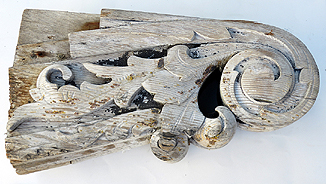
|
SHIP’s BILLET HEAD. Rare, genuine American sailing ship’s prow decoration known as a “billet head.” This handsome example of the shipcarver's art dates from the 3rd quarter of the 19th century and was executed by a master carver. The distinctive graining of the wood indicates that it was carved from Douglas Fir, a tree indigenous to the Pacific Northwest. This observation is consistent with where the billet head was last discovered -- in Coronado, California. During the1870's and 80's the "boom or bust" growth in Southern California was in full swing, sparked by the legendary westward movement beginning with the San Francisco Gold Rush in 1849. The proximity of inland salt waterways in the Northwest and the rich natural timber resources there, created a burgeoning shipbuilding industry in the Puget Sound area of Washington state. As a result, shipbuilding and timber harvesting were the two leading industries in that region from 1870 through 1910. In order to fill the growing demand for timber in California, the Northwest shipyards built scores of lumber schooners to ply the trade. It is most likely that this billet head is a relic of one of those remarkable ships. Several early Albumen images in the collection of the San Diego Maritime Museum are of ships laden with timber in San Diego Harbor during the 1880’s. Some of those images depict sailing ships at dock with their figureheads and billet heads! The surface of this scarce relic is weathered and bleached, with traces of the original gilding and early paint. Indicative of its shipboard use, there are also a couple of old bronze screws present in the base. Overall very sound, sturdy conditiion. 27 inches long by 14 ½ inches wide and 8 ½ inches thick, weighing 33 pounds. M.V. Brewington, in his reference work entitled “Shipcarvers of North America,” 1962, Barre Publishing Co., Barre, Massachusetts, depicts a series of ship billet heads on page 118. They are depicted in chronological order, the earliest being about 1830 and the latest circa 1900. In style and size, the billet head offered here is most closely represented by the example identified as being “about 1880.” |
From Viking times ships have been adorned with carvings to soothe the sailors' fears and superstitions about the vast, unfathomed sea. As the 19th century waned, elaborate and expensive shipboard decorations began to diminish. The "billethead" represents the last hurrah of the shipcarver, as a transition from the traditional and elaborate figurehead to the more austere, and cost effective ship's prow decoration.
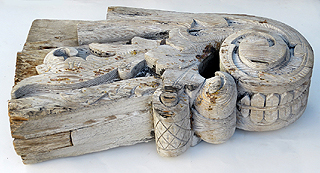
|
AMERICAN ORRERY. Rare, large solar system model constructed of wood and brass with a nickeled plaque reading "Laing's Planetarium Patented March 2nd 1897 The Trippensee Mfg Co. Detroit Mich. U.S.A." This intriguing apparatus features a large brass sphere representing the sun about which Venus, the Earth, and the Earth's moon rotate. Relative planetary motion is accomplished through a complex series of of runners and pulleys rove with linen thread. A working compass is inset in the main wooden arm next to the maker's plate. The entire assembly is supported by a decoratively turned wooden column mounted to a heavy metal base which is fitted with a disc indicating the seasons, signs of the Zodiac, and months of the year. This large orrery stands 18 1/2 inches tall and approximately 34 inches wide at the extreme dimension. The globe of the earth is constructed in the traditional manner with engraved paper gores and is signed "6 inch Globe, C.E. Weber, Chicago, Ill." All aspects are functional and in a remarkable state of preservation noting only one small dent in the brass sphere of the sun, which retains its original bright lacquered finish. A most desirable and readily displayable 19th C. planetary model.

|
MARK V DEEP WATER HELMET. The all-time classic hard hat diving helmet, a U.S. Navy Mark V "Gas Hat!" This incredible state-of-the-art (for its time) deep sea diving helmet took divers to the unheard of inky depths of 800 feet and more! The nameplate on this authentic example reads "UNITED STATES NAVY DIVING HELMET MARK V MOD-1 SERIAL NO. 133 DATE OF MFG 04-47 DIVING EQUIPMENT SUPPLY CO. INC." The condition of this helmet is pristine, retaining all of the original tin and free of dents. The underside of the breastplate is stamped "NEPTUNE DIVING ACADEMY, BKLYN N.Y. 9-21-71 DISPLAY ONLY." -- no doubt the reason that this helmet has survived in such a wonderful state of preservation. Diving collectors, this is THE ultimate hat!

|

|

|
SAILOR'S DITTY BOX. Important identified U.S. Navy seaman's China station cruise box from the turn of the last century. This remarkable relic is constructed of hand dove-tailed mahogany or similar hardwood, and is intricately carved on the top depicting two fierce Chinese dragons in the clouds encircling an American eagle perched on crossed American flags with the relief carved inscription "S.N. US.N." (sic). The carving is of exquisite detail showing the individual scales on the dragons and extremely fine plumage on the eagle. Undoubtedly this piece of art was commissioned by its sailor-owner of a master Chinese carver. The inside of the hinged lidded box is equally remarkable. A fitted panel is held in place in the lid by a small pivoting brass stay. The panel is beautifully painted with a bulldog surrounded by fancy script reading "ASIATIC STATION / HELENA - MONADNOCK / 1902 / 1906 / TROPHY." The neck of the bull dog is signed "G R Schneider," most certainly the name of its skilled shipboard painter/artist. The box is complete with lift out compartmented tray and its original box lock with key, which still works! The front of the box is nicely painted with the initials "J.B.W." Each side of the box is fitted with the original carved cleats which may have held ropework beckets for carrying. The box measures 15 inches wide overall, by 8 1/2 inches high and 10 inches deep. Condition outstanding and untouched. The only flaw that exists a small chip in the panel lid. We have never come across an identified sailor's ditty box of this quality before or since!
The armed cruiser USS HELENA was launched by the Newport News Shipbuilding Co., Newport News, Virginia on January 30, 1896. As a newly built ship of the line, HELENA saw battle action in Cuban waters during America's war with Spain. On the 2nd and 3rd of July 1898 she exchanged fire with enemy shore batteries at Fort Tunas. On July 18th she was part of the squadron which closed the port of Manzanillo by sinking and destroying 8 small vessels there in a vigorous attack. A large problem confronting the United States after the war was the Philippine Island Insurrection. To aid in the problem HELENA was dispatched from Boston on November 3rd via the Suez canal for Asiatic Station. HELENA remained in the Far East for the remainder of her career. She served in Chinese waters from October 1900 until March 1903 and was decommissioned in April 1905.
The USS MONADNOCK was a twin-screw, iron-hulled, double turreted monitor laid down by the Continental Iron Works in Vallejo, California in 1874 and was finally commissioned at the Mare Island Navy Yard on February 20, 1896. With the outbreak of the war with Spain MONADNOCK was ordered to join Admiral Dewey's fleet in the Philippines, arriving in Manilla Bay in August 1898. There she performed blockade duty. After the war she was assigned to Asiatic Station and cruised the rivers of China, particularly the Yangtze, protecting the foreign settlement in Shanghai, through January 1905. She was decommissioned in the Philippines in March 1909.
The inscriptions on this box clearly match the colorful histories of the two vessels on which it served.
NAVAL CERAMIC. Very early English Staffordshire creamware pitcher, the type of which is also commonly known as a "Liverpool Jug." This glazed porcelain pitcher features three transfers. The obverse is entitled "TOM TRUELOVE GOING TO SEA" with a charming scene depicting a young sailor consoling his lovely mistress, quite distraught at his imminent departure. The sailor's ship is seen in the background and a rousing poem embellishes the bottom. The reverse shows a 3-masted man-o-war flying the British naval ensign above crossed flags and a cannon. A third vignette is under the spout which depicts 3 sailors in a rowboat using a lead line. This jug has professional restoration, which is not apparent, in the areas around the spout and handle. An old hairline crack also exists above the sailor's head. Such distress is consistent with the age and use of this form of ceramic and is perfectly acceptable amongst collectors, considering the age and scarcity of these delicate objects. This jug measures 9 inches tall and 8 1/2 inches wide at the widest point. Extremely rare.
For a nearly identical example entitled "The Sailor's Adieu" and dated 1800, see Plate 90, Gordon Pugh, "Naval Ceramics," The Ceramic Book Company, Newport, England, 1971.
SWASTIKA-MARKED WWII CHRONOMETER. Very rare and highly collectible 2 day marine chronometer made by the Ulysse Nardin company of Switzerland for the German Third Reich. This handsome World War II ship's timekeeper is of standard form with black spade hands and a white enameled dial signed "ULYSEE NARDIN Locle Suisse." The serial number "4914" appears in red within the seconds bit. The hours are marked with Roman Numerals and the 56 hour UP/DOWN indicator is also marked "HAUT" and "BAS." The superb quality gilt-finished movement is of the spring détente type with fusee and is stamped with the Nardin trademark and serial number "4914" on the backplate. It is housed in its original brass bowl and gimbal apparatus, the surfaces of which bear the original lacquer. These in turn are housed in the original lovely brass-bound mahogany box with "ULYSSE NARDIN Le Locle (Suisse)" nameplate on the front and matching serial number plate "4914." Of exceptional note is the fact that the bottom of the bowl of this chronometer was engraved with the German eagle perched atop a swastika and the Navy serial number "M2381" indicating its official service aboard a Commissioned German Naval vessel during the war! The movement of this chronometer has just been professionally serviced by a former employee of the Mercer chronometer company in England and is guaranteed to be in top running order. Box measures 7 1/2 inches cubed. Complete with original ratcheted chronometer winding key and original box lock key! Outstanding original, unmodified condition in all respects. Authenticity guaranteed.
The quality of the marine chronometer produced by the Nardin firm was so highly respected that it became the standard from which the famous American-made Hamilton chronometer was copied in 1940. Research performed by our friends in Germany indicates that this example was produced in 1944 and delivered to the German Navy. The M stands for "Marine" and 2348 is the number for chronometers. Further research might well identify the specific vessel on which this chronometer served.
TAMBOUR DESK. Mid 19th C. Chinese export campaign style brass-bound camphorwood roll top desk with fold-out writing slope and pop-up pigeon hole compartments with 2 drawers. A second set of compartments, one with lid, is located just behind the writing slope. The interior writing surface is in the original old green fabric, in worn condition. Pulling out the large lower drawer opens the roll top and provides a rest for the writing slope. Once the tambour top is open the inner compartment may be lifted up and held in position by two wooden spring like pawls. Two minor age cracks in the right side. Excellent condition throughout with good original exterior surfaces, showing expected wear. 19 inches wide x 15 1/2 inches deep, closed.
SCRIMSHAW FID. Truly amazing 19th C. sailor's fid or Marlin Spike with a long tapered shaft constructed entirely out of single piece of walrus tusk ivory! This extra large genuine working scrimshaw tool measures 14 inches long overall, with the ivory portion being just shy of one foot in length! The hefty mahogany handle is very securely attached to the ivory by a stout copper spike which has acquired a deep age patina. The entire tool is in outstanding original condition showing actual use but no abuse, and exhibits nicely aged surfaces throughout. This is the first genuine working fid constructed of marine mammal ivory that we have ever seen. Certainly a museum piece.
FAMOUS NAVAL ARCHITECT'S 'INTEGRAPH'. Late 19th century mechanical integrator made for the American market and imported by the famed New York scientific instrument firm Keuffel & Esser. This complex precision instrument is made from brass and nickel silver. The Keuffel & Esser label in the lid indicates "Coradi's Mechanical Integrator No. 1109/29," accompanied by a series of conversion tables hand-written in lovely script. A third label Reads "Examined and found in perfect condition 6/8/97." An abstract from a period Keuffel & Esser catalog gives insight into this complicated device. "Like the Mechanical Integrators, the Integraph, in a very short time comparatively has proved to be an aid of no small consideration to Civil and Mechanical Engineers and especially to Naval Architects." This rare example was owned and use by famed American naval Architect William Gardner, as confirmed by accompanying documentation. The instrument is complete in its original hand dove-tailed walnut case containing all attachments and measuring 15 inches wide by 11 1/2 inches deep. There is a shrinkage crack across the tip of the lid and the box lock has been removed. The top of the box bears its original heavy folding brass carrying handle and the front of the box retains both closing hooks and eyes with fancy key escutcheon plate. Outstanding, well preserved condition.
This mechanical integrator was acquired by nautical collector Grandon Stirling, now deceased, from the daughter-in-law of William Gardner in Virginia Beach, Virginia in the 1970's.
"William Gardner, designer of the ATLANTIC, was one of the leading American designers, on the same plane of achievement as Steers, Lawlor, Cary Smith, Burgess and Herreshoff. He was born in Oswego, New York, and was a graduate of Cornell University. After graduation he was employed by the John Roach shipyard before leaving to attend the Royal Yacht College in Greenwich, England. In 1886 Gardner returned to New York opening an office as a naval architect. In the ensuing years Gardner turned out a great many fine yachts; the schooners, ALCEA, QUINSETTA and RADIANT and the cutters NOROATA, SYCE, NEOLA, ASPIRANT and the Cup defense candidate VANITE, of 1914, amongst them. Gardner retired from active designing in 1925." Howard Chapelle, "The History of American Sailing Ships," 1935, W.W. Norton & co., New York, p.350. There can be little doubt that this very Integrator was employed by Gardner in designing most of these famous yachts!
TELESCOPE CANE. Important mid-19th C. gentleman's walking stick, probably English, made of gracefully tapered rosewood with a brass handle and cap. Unscrewing the cap of this "gadget cane" reveals a slim, instrument grade, single draw brass spyglass hidden within the upper shaft. This telescope is NOT a toy. It is covered in its original leather, extends to 11 inches in length, and produces a clear, magnified image with the original 5 element lens system. All lenses are original and perfect. Condition of the entire presentation is outstanding, noting only minor expected wear and shrinkage of the leather on the telescope due to age. The cane itself is also in mint condition with absolutely no flaws, showing a deep age patina to the marble grained rosewood, and complete with original ferrule tip. 33 inches long. The real beauty of this dual purpose walking stick is its deceptively slim nature, which does not indicate that it has a secondary function! A truly rare antique cane.
IMPORTANT PAINTING. Francis Hustwick (1797-1865), British, 19th century, oil on canvas rendering of an encounter at sea. In this scene this famed marine artist has captured the rare subject matter of a full rigged sailing ship under shortened sail approaching a paddle wheel steam sailer in heavy seas. This dramatic encounter depicts the paddle wheel steamer with several crewmen on deck as if in anticipation of the ship's approach. The steamer flies the British ensign (Union Jack) and also Hustwick's famous "signature" flag, the pre-1801 red ensign. Signed lower right "F. Hustwick." This museum-quality painting measures 21 by 31 inches site and is housed in its magnificent original gilt gesso frame measuring 28 1/2 by 38 1/2 inches. Inspection under black light reveals it is in excellent original condition with only the most minimal inpainting touch ups, likely done during relining. A brass label on the bottom center of the frame reads "Steam & Sail, Francis Hustwick, exh 1818-1839." A truly spectacular painting by one of England's most accomplished 19th century marine painters.
Noted marine painting authority, A.S. "Sam" Davidson, author of many books on English marine paintings, recently published what may be considered his most revealing work to date, "Marine Art & Liverpool - A Postscript, Fifty Ship Paintings by Francis Hustwick," 1999, Jones-Sands Publishing Co., Wirral, England, in collaboration with Anthony Tibbles. In it Davidson successfully "connects" a number of heretofore anonymous marine paintings with Francis Hustwick by using the unique pictorial "signature" (rebus) of the outdated red British ensign before 1801, common to all. In his scholarly research work, well documented with fine color plates of the other known paintings, Davidson indicates only two signed Hustwick paintings known at the time of printing. This lovely example makes the third. It is interesting to note that the subject matter in this painting is unique. None of the other paintings represented shown in the book depict vessels in stormy seas. A copy of the book, signed by the author, is included with this offering.
IDENTIFIED U.S. NAVY HALF MODEL. Very important late 19th C. shipyard builder's half block model of the U.S. Navy torpedo boat USS FARRAGUT as boldly hand-painted on the backboard. This sculpted wooden hull plating model shows intricate hand painted hull details including the location and numbering of frames, strakes and individual hull plates. The unusual "turtle" foc'sle is clearly in evidence as is the prominent forward gun turret. This graceful vessel with "ram bow" and "cruiser stern" also shows the protective propeller shaft housing. The model itself measures 53 1/2 inches long with the backboard 5 feet by 9 1/2 inches. Condition is outstanding and completely original. The nicely oxidized and patinated surface shows good age and desirable original old variegated finish. This model has been in the collection of the DeYoung Museum, San Francisco, California for the past 100 years. A rare U.S. Navy builder's model with important museum provenance. Complete with an original photo of this type of boat, dated 1901, and documented historical background.
The USS FARRAGUT (Torpedo Boat 11) was launched on July 16, 1898 by the Union Iron Works in San Francisco, California in response to the call to arms stirred by the Spanish-American War. Farragut spent the early days of her service patrolling the California coast Between San Diego and San Francisco. Toward the end of her career, during the First World War, she patrolled the Panama Canal Zone on both the Pacific and Atlantic frontiers. Then, renamed Torpedo Boat No. 5, she was decommissioned at the Mare Island Navy Yard, San Francisco on March 13, 1919.
BACK STAFF. Rare, first half of the 18th century mariner's navigational Davis Quadrant also known as a "backstaff." This particularly handsome example of a sun sighting instrument is probably of English manufacture. It is constructed with limbs of rosewood supporting scales engraved on boxwood arcs. The large arc is calibrated from 0-25 degrees, diagonally subdivided to single arc minutes. The small upper arc is calibrated from 0-62 degrees. This remarkably well preserved instrument bears decorative stars, Tudor roses, and fleur-de-lis patterns throughout. Adding to its beauty and durability the frame is inlaid with ivory "diamonds" at the attachment points and bears an inlaid ivory maker's plate (blank) in the longest member. It has the typical early decorative "crook" on the large arc which served to provide the observer with a firm grip while sighting. It is also decorated with a large number of repetitive sunburst patterns on the edges of the arcs. The finely fashioned original boxwood horizon vane is decorated with two fleur-de-lis adjacent to the horizon slit and is impressed with the number "22." The shadow and sighting vanes are perfect boxwood replacements faithfully replicated from originals. 25 1/4 inches long by 14 1/2 inches wide. This is a lovely, very early example of the predecessor to the sextant and a genuine museum piece.
Capt. John Davis is credited with inventing the backstaff or Davis Quadrant in 1594. The instrument was used primarily for taking sun lines to ascertain latitude. Using it, the observer stood with his back to the sun, avoiding its direct glare, hence the name.
LIFESAVING CANNON. Rare, early 1900's solid brass and bronze line throwing cannon manufactured by "C.C. GALBRAITH & SON, INC. NEW YORK, N.Y. U.S.A." as relief-cast on both sides of the carriage and as stamped around the muzzle "C.C. GALBRAITH & SON MM1 729B. GSM." Correspondingly, the top of the carriage is stamped on both sides "NO. 729. MM1. GSM." This massive cannon has a forged bronze barrel measuring 32 inches long overall with a bore of 2 1/2 inches. The original brass carriage is of the "skid" type, later fitted with 4 leather covered wooden wheels. The entire unit measures 38 inches long, 25 inches high, 11 inches wide at the carriage, and 16 inches wide at the wheels. At 168 pounds it is an imposing piece which is in excellent original unpolished condition.
According to J.P. Barnett in "The Lifesaving Guns of David Lyle," Town & Country Press, Plymouth, Indiana, 1976, the production of C.C. Galbraith began in 1919. This model, with trunion collar cast as part of the barrel, went into production in 1940. Barnett writes, "This was the last model Galbraith made and in many ways represents the epitome of Lyle Gun development. Though heavier than various other guns, and lacking the ability to stow flat, the later Galbraith/Lyle guns provided reasonable portability, very good finished appearance, and good stability. Galbraith company officials indicate that Galbraith produced about 1,400 guns, the greater half after about 1940." This gun is serial numbered 729.
TELESCOPE. Extremely rare 18th C. reflecting telescope by the most noted London makers Nairne & Blunt. This early instrument is 18 inches long and stands 20 inches tall as shown, on a lovely brass cabriolet queen Anne tripod with decoratively cast floral designs on the legs. Optics in this telescope are original and produce a clear upright image. Telescope is complete with its original fitted mahogany box (cracks) and the rarely found original operating instructions (tattered). A museum piece.
Page 2 of 7
Pages « 1 2 3 4 5 6 7 »

